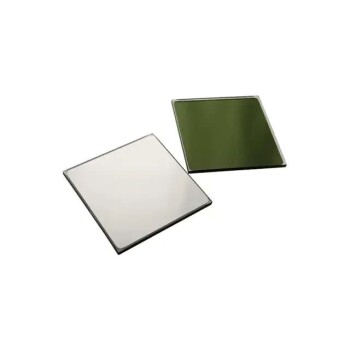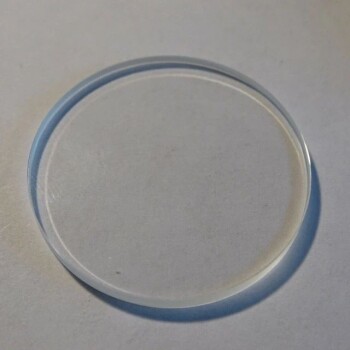
Optical Materials
Optical Ultra-Clear Glass Sheet for Laboratory K9 B270 BK7
Item Number : KTOM-OGS
Price varies based on specs and customizations
- Product thickness
- 0.1-10mm
- Transmittance
- ≥90%
- Unit of measurement
- pcs
Shipping:
Contact us to get shipping details Enjoy On-time Dispatch Guarantee.
Why Choose Us
Reliable PartnerEasy ordering process, quality products, and dedicated support for your business success.
Laboratory Optical Glass
Optical glass is a specialized glass product specifically designed for utilization in optical devices, including telescopes, binoculars, eyeglasses, and more. This type of glass is meticulously formulated to ensure its properties are precisely known. It necessitates careful handling to guarantee its purity and proper production conditions.
Details & Parts



Optical glass characteristics
- Chemical properties: Optical glass can be formulated with various additives, such as boron oxide, lead, zinc oxide, fluorite, and barium oxide, to enhance its light transmission capabilities within specific wavelengths. The chemical composition of the glass determines how different wavelengths of both visible and invisible light are absorbed, transmitted, or refracted, allowing for the desired optical effects in various applications.
- Mechanical behavior: Optical glass is highly regarded for its exceptional clarity, purity, and hardness in comparison to other glass types. It possesses notable density, reaching up to 6.19 g/cm³. Flint glass, in particular, tends to be denser than crown glass due to the inclusion of lead in its composition.
Applications of Optical Glasse
Optical glass, renowned for its remarkable clarity and durability, finds extensive applications in various optical fields, including:
- Lenses for analytical and medical equipment
- Photographic lenses
- Windows for optical systems and instruments
- Glass substrates
- Lead radiation glasses
- Precision lenses
- Pressure sensors
- Laser systems
- Beam splitters
These applications benefit from the exceptional optical properties and reliability of optical glass, making it the preferred material for a wide range of optical components and devices.
Provide customized services
Through the implementation of innovative and state-of-the-art melting processes, we have acquired extensive expertise in the development and manufacture of quality glass products, offering a wide range of optical glass products for a variety of commercial, industrial and scientific applications. The company provides various specifications of optical glass such as raw glass, cut parts and finished components, and cooperates closely with customers to customize products according to customer needs. With an unwavering commitment to quality, we ensure our customers receive the perfect solution tailored to their requirements.
For further quotations, please contact us.
FAQ
What Are The Main Types Of Glass Substrates?
What Is Optical Glass Used For?
What Is Soda-lime Glass Used For?
What Is The Composition Of Optical Glass?
What Are The Advantages Of Using Sapphire Substrates?
What Are The Most Common Optical Glasses?
Why Is Boroaluminosilicate Glass Suitable For Laboratory Glassware And Cooking Utensils?
What Are The Applications Of Optical Quartz Glass Sheets?
What Makes K9 Glass Special?
What Is A CaF2 Window Used For?
What Are The Properties Of Magnesium Fluoride Crystal Substrates?
What Is Silicon Used For In The Near-infrared Range?
What Are Glass Vibration Beads Used For In Laboratories?
4.9
out of
5
These KINTEK SOLUTION glasses are a great addition to our lab. They're durable, easy to use, and provide clear visibility.
4.8
out of
5
The quality of these glasses is top-notch. They're made from high-quality materials and are built to last.
4.7
out of
5
I'm impressed with the value for money of these glasses. They're affordable and offer excellent performance.
4.9
out of
5
These glasses are a breeze to use. They're easy to set up and maintain, which saves us time and effort.
4.8
out of
5
The technological advancements in these glasses are impressive. They're equipped with features that make our work more efficient and accurate.
4.7
out of
5
The speed of delivery for these glasses was exceptional. We received them within a few days of placing our order.
4.9
out of
5
I highly recommend these glasses for any laboratory. They're a great investment that will pay off in the long run.
4.8
out of
5
These glasses are a must-have for any laboratory. They're reliable, durable, and provide excellent results.
4.7
out of
5
I'm very satisfied with the quality of these glasses. They're made from high-quality materials and are built to last.
4.9
out of
5
These glasses are a great value for the money. They're affordable and offer excellent performance.
4.8
out of
5
The delivery of these glasses was very fast. We received them within a few days of placing our order.
4.7
out of
5
I'm very impressed with the technological advancements in these glasses. They're equipped with features that make our work more efficient and accurate.
REQUEST A QUOTE
Our professional team will reply to you within one business day. Please feel free to contact us!
Related Products

Optical Window Glass Substrate Wafer Single Double Sided Coated K9 Quartz Sheet
K9 glass, also known as K9 crystal, is a type of optical borosilicate crown glass renowned for its exceptional optical properties.

High Temperature Resistant Optical Quartz Glass Sheet
Discover the power of optical glass sheets for precise light manipulation in telecommunications, astronomy, and beyond. Unlock advancements in optical technology with exceptional clarity and tailored refractive properties.

400-700nm Wavelength Anti Reflective AR Coating Glass
AR coatings are applied on optical surfaces to reduce reflection. They can be a single layer or multiple layers that are designed to minimize reflected light through destructive interference.
Related Articles

Optical Quartz Plate: A Comprehensive Guide to Applications, Specifications, and Usage
Discover the versatility of optical quartz plates, exploring their uses in various industries, key specifications, and factors that differentiate them from glass. Gain insights into their applications in ultraviolet transmission, precision optics, and more.

Unveiling the Exceptional Properties and Applications of Optical Quartz Plates
Discover the remarkable characteristics and diverse applications of optical quartz plates, including their superior ultraviolet transmission, thermal stability, and use in lenses, lighting devices, and semiconductor manufacturing.

Unlocking the Power of Optical Quartz Plates: Applications and Benefits
Delve into the world of optical quartz plates, exploring their exceptional properties, diverse applications in industries like optics, electronics, and more. Discover their advantages, including low thermal expansion, high temperature resistance, and precise optical clarity.

How To Clean Laboratory Glassware - Part 2
How To Clean Laboratory Glassware? Here are some considerations and tips.

How To Clean Laboratory Glassware - Part 1
Cleaning laboratory glassware isn't as simple as washing the dishes. Here's how to wash your glassware so that you won't ruin your chemical solution or laboratory experiment.

A Step-by-Step Guide to Cleaning Laboratory Glassware
Maintaining clean and sterile glassware is crucial in any laboratory setting. Not only is it important for the accuracy and reliability of experiments, it is also essential for the safety of those working in the lab.

Glassware vs. Plasticware - Which is the Better Choice for Your Needs?
Both glassware and plasticware have their own advantages and disadvantages, and the choice between the two will depend on the specific needs of your laboratory.

Safety Equipment In A Lab - Eye Protection
Safety glasses or chemical goggles must be donned before entering any wet bench lab, including cell culture labs. This applies to lab visitors, GT maintenance and custodial workers as well as staff and students.

Comprehensive Guide to Atmosphere Furnaces: Types, Applications, and Benefits
Explore the world of atmosphere furnaces with our detailed guide. Learn about their types, applications in metallurgy and beyond, and the benefits they offer for precise material heat treatment.

PTFE Cleaning Racks: The Ultimate Guide to Cleaning and Drying Labware
In this comprehensive guide, we'll delve into the world of PTFE cleaning racks, exploring their benefits, applications, and the best practices for cleaning and drying labware to ensure optimal performance and longevity.

Exploring the Fundamentals of Good Laboratory Practice: Ensuring Quality, Integrity, and Safety in Scientific Research

Revolutionize Your Spectroscopy Analysis with FTIR Pellet Press
FTIR (Fourier Transform Infrared) spectroscopy is a widely used technique to analyze the chemical composition of various materials. This method is particularly useful for samples that are difficult to analyze using other techniques.